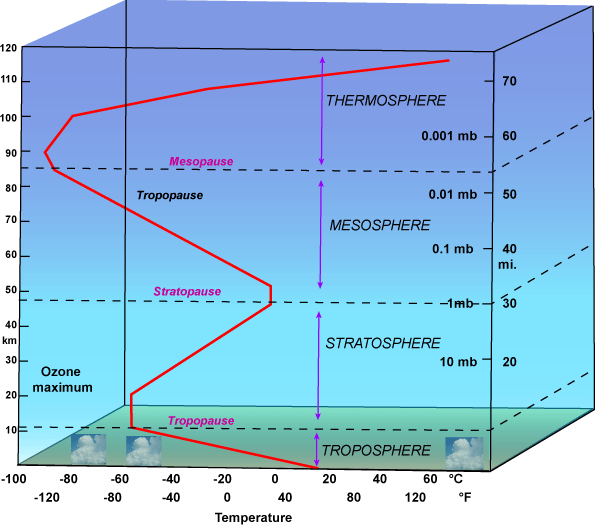Climate summary, with pretty pictures
I never know how much of what I say is true. - Bette Midler
Here's a summary of the heat flows in the Earth's lower atmosphere, surface, and clouds. If the total incoming solar radiation power stream is 100 units,*
- Solar radiation in reflected by clouds = 35
- Solar radiation in absorbed by clouds = 19
- Solar radiation that reaches surface = 46
- Atmospheric heat flow downward to surface = 49
- Net latent heat of water released = 22
- Heat convected upward from surface = 10
Look at just surfaces, clouds, and lower atmosphere as wholes: six mechanisms modify the pure incoming solar radiation, three enhancing, three anti-enhancing:
Modification of heat flow Effect on tempsLook at the whole temperature profile and consider the lapse rate: four mechanisms modify the dry adiabatic lapse rate:
--------------------------------------------------------------------------
Net latent heat released from
water evaporation-condensation up
Convection in clear air up (clouds only)
Clouds as radiators down up
Clouds as reflectors up down
Clouds as efficient convectors up down
Clouds as radiators up down
Modification of heat distribution Effect on lapse rateOverall, condensation (release of latent heat) wins, and the dry adiabatic lapse rate of 9.8 oK/km is moderated to about 6.5 oK/km. Two previous postings, on tropospheric temperatures and lapse rates, contain more details and have been revised somewhat for accuracy and clarity.
--------------------------------------------------------------------------
Condensation: release of latent heat shallows
Condensation: loss of water vapor pressure steepens
Convective heat transport steepens
Radiative heat transport thru water vapor steepens
The water- and convection-driven temperature enhancements are frequently compared to the 250 oK = -23 oC = -9 oF climate with reflective but otherwise unreal clouds and no evaporation, implying internal enhancement of surface temperature of +38 oK, to 288 oK. But a better baseline is the 279 oK = 6 oC = 43 oF dry atmosphere, with a +9 oK net enhancement due to all the effects of water and convection taken together, both enhancements and diminutions. This baseline is well-defined physically, while the other is based on isolating one effect of water (cloud reflectivity) and leaving the others out.
I've been asked to leaven the steep scientific climbing of the last couple weeks' postings on climate with something a little easier. Here's a neat graph of the atmosphere's temperature profile. The troposphere shows off its 6.5 oK/km lapse rate:

(From Lyndon State College, Vermont, meteorology notes.) The height is marked in both miles and kilometers. The pressure is marked in millibars: the surface pressure is about 1010 millibars. Of course, there's more going on above the troposphere - an upcoming posting will explain what happens in the upper atmosphere and why it's important for us down here. And here's a nice summary of all the heat flows into and out of the atmosphere. This diagram divides up the energy flows in a different and more detailed way from our approach, but the results are nearly the same.
Finally, there are clouds:

(From the exquisite online photo archive of Redvest.) Clouds are wonderful things - like snowflakes and people, no two are alike. The theory I've used in the last month to explain clouds isn't the full theory - no one can solve it - but a highly simplified model that treats clouds as stable horizontal slabs of dense water droplets. Real clouds are everyday reminders of dynamical chaos and pointers to the deep reasons why weather is repetitive and yet unpredictable.
---
* These numbers closely match the classic results of Budyko, with slight differences due to a different "solar constant" (incoming radiation power flux, watts per square meter) and including the effect of the cloudier southern hemisphere. I've ignored the tiny absorption of incoming radiation by the upper atmosphere. Mean cloudiness = 0.54.
** Water really is a miracle compound. (See here.) On alternate Tuesdays, it's enough to make me believe in a just and benevolent G-d.
Labels: climate


0 Comments:
Post a Comment
<< Home